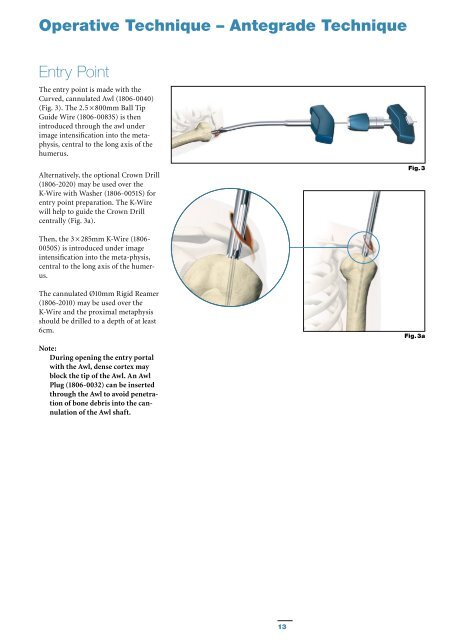T2 Humeral Nailing System Operative Technique - Stryker
T2 Humeral Nailing System Operative Technique - Stryker
T2 Humeral Nailing System Operative Technique - Stryker
Create successful ePaper yourself
Turn your PDF publications into a flip-book with our unique Google optimized e-Paper software.
<strong>Operative</strong> <strong>Technique</strong> – Antegrade <strong>Technique</strong><br />
Entry Point<br />
The entry point is made with the<br />
Curved, cannulated Awl (1806-0040)<br />
(Fig. 3). The 2.5 × 800mm Ball Tip<br />
Guide Wire (1806-0083S) is then<br />
introduced through the awl under<br />
image intensification into the metaphysis,<br />
central to the long axis of the<br />
humerus.<br />
Alternatively, the optional Crown Drill<br />
(1806-2020) may be used over the<br />
K-Wire with Washer (1806-0051S) for<br />
entry point preparation. The K-Wire<br />
will help to guide the Crown Drill<br />
centrally (Fig. 3a).<br />
Then, the 3 × 285mm K-Wire (1806-<br />
0050S) is introduced under image<br />
intensification into the meta-physis,<br />
central to the long axis of the humerus.<br />
The cannulated Ø10mm Rigid Reamer<br />
(1806-2010) may be used over the<br />
K-Wire and the proximal metaphysis<br />
should be drilled to a depth of at least<br />
6cm.<br />
Note:<br />
During opening the entry portal<br />
with the Awl, dense cortex may<br />
block the tip of the Awl. An Awl<br />
Plug (1806-0032) can be inserted<br />
through the Awl to avoid penetration<br />
of bone debris into the cannulation<br />
of the Awl shaft.<br />
13<br />
Fig. 3<br />
Fig. 3a

















